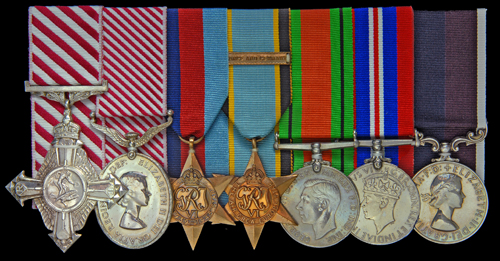
Auction: 8010 - Orders, Decorations, Medals & Militaria
Lot: 119
A Rare ´E.II.R.´ A.F.C., A.F.M. Combination Group of Seven to Britannia and Liberator Master Engineer Later Flying Officer R.E. Anstee, Royal Air Force a) Air Force Cross, E.II.R., reverse officially dated ´1963´ b) Air Force Medal, E.II.R. (1587259. F. Sgt. R.E. Anstee. R.A.F.) c) 1939-1945 Star d) Air Crew Europe Star, with France and Germany Bar e) Defence and War Medals f) Royal Air Force Long Service & G.C., E.II.R. (M. Eng. R.E. Anstee. (1587259). R.A.F.), light contact marks throughout, therefore very fine or better, mounted court style for display, with a photograph of the recipient the group with the following original and related documentation: - Named Investiture invitation, dated 18.6,1954 - (9) Letters of congratulation to the recipient on the occasion of the awards of his A.F.C. and A.F.M., including from Air Chief Marshal Sir E. Hudleston; Air Chief Marshal Sir R. Ivelaw-Chapman; Air Marshal Sir G.H. Mills and Air Marshal Sir W.F. Dickson - Typed report by the Pilot of Britannia XM 519, for it´s flight from Khormakser to Gan 16.12.1962, during which the recipient came to the fore as the engine failed, a similar report titled Good Show detailing Anstee´s gallantry on Britannia XL 636´s flight from Rome to Lyneham, 15.11.1962, his conduct on both flights leading to the award of a well deserved A.F.C.; a copy of an article written on the same incident, which appeared in Aviation News, November 1988, and (2) newspaper cuttings (lot) Estimate £ 4,000-4,500 A.F.C. London Gazette 8.6.1963 Master Engineer Robert Edward Anstee, A.F.M. (1587259), Royal Air Force. A.F.M. London Gazette 10.6.1954 1587259 Robert Edward Anstee, Royal Air Force. Flying Officer Robert Edward Anstee, A.F.C., A.F.M., served during the Second World War as a Flight Engineer with 519 Squadron (Sterlings) flying over targets in Europe, before postings to 214, 159, 115 and 511 Squadrons, with whom he flew in B-17´´s, Halifax´´s, Mosquito´´s, Lancaster´´s, Britannia and Liberator bombers; awarded the A.F.M. in 1954, as part of the crew which won the blind bombing trophy; whilst serving with 511 Squadron (Britannia´´s), Lyneham, Anstee took part in two eventful flights which were to contribute to the award of his A.F.C., the first, ´´On 15th November, 1962, Britannia XL 636 was inbound to Lyneham, flying at 22,000 feet, position 100 n.m. north of Rome. Suddenly, the freight bay alarm sounded and the cockpit began to fill with thick smoke. M. Eng. Anstee checked the smoke indicator and discovered that the origin of the fire was in the forward freight hold. While the rest of the crew put on their oxygen masks, he went down into the forward freight hold to investigate. Meantime, the Hobson Feel Simulator was off-loaded, the C.C.W.R. and most of the radio equipment switched off. After 3-4 minutes, the Engineer [Anstee] appeared, almost asphyxiated, to say that he could not trace the source of the smoke. An emergency diversion to Rome was commenced immediately, meanwhile the Engineer went below again, this time ably assisted by the Signaller, M. Sig. J. Beardon. A short while later he re-appeared to report that he thought the fire was in the feel simulator. The flight to Lyneham was resumed at reduced airspeed and the emergency cancelled. The C.C.W.R. and radio equipment were switched back on. Within minutes the fire alarm sounded again and the cockpit filled with smoke. Once again the Engineer went down into the forward freight hold. This time he was able to diagnose the fire as being in the C.C.W.R. He emerged from the freight hold choking and in a state of near collapse. The smoke in the cockpit by this time was so thick that the Navigator was only just visible from the Captain´´s position - it can be imagined that the conditions in the freight hold near the seat of the fire were almost impossible. The engineer´´s efforts were particularly praiseworthy. To gain access to the freight hold, he had to cut through the cargo net which was lodged against the access hatch and then move some roller conveyors which blocked his way into the hold. To make matters worse, the tube on the smoke mask proved to be far too short so that he had to keep returning to the hatchway into the fuselage to obtain his breath. Despite all this, he kept returning to ascertain the cause of the fire until he was almost completely overcome. M. Eng. Anstee is a very large person and is not able to move easily in the confined space of a freight hold. His Captain, Flt. Lt. N.E. Rose comments:- "I consider that he showed tenacity and strength of character and reflected great credit on his training and his Squadron. Flight Safety Comment - This incident led us to seek an improved smoke mask for use on Britannia aircraft. We are now asking for the Siebe Gorman Closed Circuit Oxygen Breathing Appartus to be provisioned." (Typed report included with in the lot refers). The second flight where technical problems were encountered by Anstee occurred a month later in Britannia XM 519 on the 16th December, whilst on a routine sortie from Aden to Gan over the Indian Ocean. During the flight it was discovered that No. 4 propeller had broken loose from its engine and was running wild. Anstee was not able to feather the propeller but by reducing air speed to 120 knots and dropping down to sea level, he was able to reduce the RPM of the 16 foot whirling propeller to approximately the same speed as the other three and thus reduce the danger of the propeller breaking off and striking either the adjacent engine or the flight deck. The descent through the clouds made control a nightmare. Next it was discovered that at such low altitude the plane did not have enough fuel to reach Gan. Since they were past the point of no return, they had to consider ditching the plane in the ocean about 50 nautical miles from Gan. At this point, an all too stark fact was apparent - no one had ever successfully ditched a Britannia in deep water, and lived to tell the tale. The crew sent out a MAYDAY call and ditching preparations were made as they flew on. An Air Sea Rescue Shackleton was scrambled once the MAYDAY was received and an A.S.R. Launch and helicopter were on standby at Gan, ´´As we descended, the crew had clicked into the many and necessary drills like a well-oiled machine. The painstakingly disciplined training the RAF had put us through in the classroom and hours of emergency drills in the Britannia simulator, now more than paid off. The aircraft had been depressurised, we had donned our lifejackets and had rehearsed ditching drills. The engineer had gone aft and helped the AQM to prepare the aircraft for ditching by strengthening the lashings. We had considered jettisoning the freight but most of the Sea-Slug missiles were too big to move and we felt anything else could strike the tail plane due to the very high nose-up attitude at our low airspeed. Bob [Anstee] continuously monitored the appearance of No. 4 engine through the fuselage windows for signs of deterioration..... And now, despite all our other problems, George announced that we did not have enough fuel to reach Gan! Even if the propeller didn´´t come off and hit the fuselage, or the engine catch fire or disintegrate, we were now faced with an inevitable ditching and a possible watery grave. Down near the sea surface the ambient (outside air) temperature was around 90 degrees Fahrenheit with near 100 percent humidity. The greenhouse effect on the flight deck made it far hotter (the Britannia air conditioning system was almost non-existent when unpressurised at low level)." (Aviation News article included in the lot refers). The Shackleton reached the ailing Britannia about an hour out from Gan, and shadowed her on her wing as the crew continued to struggle to get the aircraft home. With Gan coming into sight, rather than risk ditching, they decided to hang on, the gamble paid off with the plane landing safely with the fuel gauge reading zero, ´´We performed our shut down checks in a sort of unreal euphoria. The Station Commander, Wing Commander Peter Ellis and ground crews crowded on to the aircraft to see if we were all right. Before departing to send signals of our safe arrival the Station Commander handed over a crate of ice-cold Tiger Beer and we sat, dehydrated, on the aircraft steps in the setting sun. As we sat there the big dark grey Shackleton roared low across the aircraft pan in salute". Anstee was awarded the A.F.C. and commissioned Flying Officer in 1963. After retiring from the R.A.F. Anstee took up a post with Pakistan International Airline, and acted as Flight Engineer on the Sultan of Oman´´s private jet. 1 of only 9 E.II.R. A.F.C./ A.F.M. combinations to have been awarded.
Sold for
£5,000




